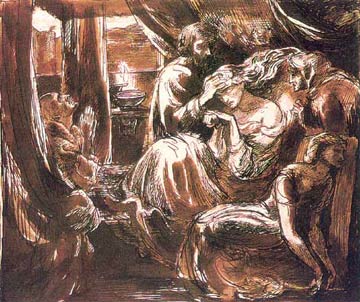
Macbeth is such a powerful play that we fear invoking the name of it in the theatre. It’s one of Shakespeare’s greatest tragedies and with so many dramatic elements, I’m surprised that the Pre-Raphaelites did not illustrate it more. Murder, greed, ambition, fear…Macbeth has it all.
The Rossetti drawing above is a preliminary study for a painting that he intended to paint on canvas, but the painting never came to fruition.
Lady Macbeth is her husband’s partner in crime in the truest sense of the phrase. She is a formidable figure and together, they plunge headfirst into a murderous plan that spirals out of control. She is just as complicit as her husband. Perhaps this is why she isn’t seen often as a Pre-Raphaelite subject, since she would be the antithesis of the young, naive Ophelias that we see again and again in Pre-Raphaelite works. Not that innocent damsels were all they painted. There are many examples of femme fatales and fallen women. But Lady Macbeth, by comparison, is curiously underrepresented.
Her death occurs offstage, so Rossetti has constructed a scene of his own imagining. She is still obsessively rubbing her hands, convinced that the bloodstains persist. “Out, damn’d spot! Out, I say!” (Act V, scene 1).
One wonders how much the death of his wife, Elizabeth Siddal, weighed on his mind while he considered Lady Macbeth as a subject. In the beginning of the play, Lady Macbeth is strong and resolute. She believes in her husband and his potential greatness. When she hears of the predictions of the weird sisters, she wants to push him into action that will make their prophecy come true. But as time passes and their murderous acts begin to effect them, Lady Macbeth begins to unravel. Walking in her sleep, rubbing her hands, speaking in broken sentences while she imagines the sight and smell of blood. The Doctor informs Macbeth that her illness in not physical, but mental. And then, offstage, she dies ‘by self and by violent hands.’
Macbeth’s reaction to his wife’s death is interesting. He has lost the capacity to feel. He is empty, drained. Which leads us to one of Shakespeare’s most famous soliloquies,spoken by Macbeth upon hearing of his wife’s death:
She should have died hereafter;
There would have been a time for such a word.
Tomorrow, and tomorrow, and tomorrow,
Creeps in this petty pace from day to day,
To the last syllable of recorded time;
And all our yesterdays have lighted fools
The way to dusty death. Out, out, brief candle!
Life’s but a walking shadow, a poor player
That struts and frets his hour upon the stage
And then is heard no more. It is a tale
Told by an idiot, full of sound and fury
Signifying nothing. — Macbeth (Act 5, Scene 5, lines 17-28)

You know this particular subject is dear to my heart! 🙂 And of course Lizzie was a handful of other Shakespeare heroines, but never (as far as I can recall) Lady M.
Puts me in mind of what Ellen tells Kate in the first season of Slings & Arrows, about how first you play the ingenues, then you play the queens, then the next thing you know you’re the Nurse. The ingenues are great characters too, but I do wish Lizzie had gotten her taste of the queens. I’m having a ball with them so far.